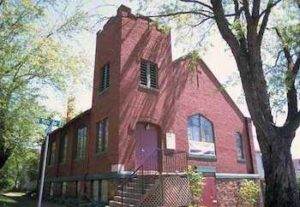
*On this date in 1888, celebrates the founding of Duluth’s St. Mark’s AME Church. This was the first and only building in Duluth built by blacks, for blacks.
Founded by Rev. Richmond Taylor, the congregation first met at Fourth Street and Fourth Avenue West. Soon afterward, it moved to a newly constructed building at 530 North Fifth Avenue East. The structure’s basement level accommodated the congregation until 1913, when the main level was completed. The simple brick building sits in a mostly residential area. It features a two-story bell tower, Tudor Revival elements, and locally made stained glass windows. Like many churches at the time, St. Mark’s in the early twentieth century offered the community a central space for religious, social, and political conversation and networking.
The local Masonic order frequently held meetings at the church, and membership there and in local Black organizations overlapped. At the time of St. Mark’s construction, most Black men in Duluth worked as janitors, waiters, porters, or dock or boat workers. A few independent barbershops and restaurants succeeded. Other employment came to Duluth via the U.S. Steel Corporation.
St. Mark's growth in its early years paralleled the growth of the Black population in Duluth, largely driven by job opportunities at U.S. Steel. In the early 1920s, the company recruited laborers from Southern states to work at their plant in Morgan Park, a planned community near the edge of Duluth. Recruits found poor wages, unfamiliar weather, and discrimination upon arrival. Though their jobs were in Morgan Park, the company town and black employees could not live there. It was a whites-only community. Most Blacks settled in Gary, which was also a company town, or the East Hillside neighborhood near St. Mark’s.
After World War I, Duluth’s blacks faced stricter Jim Crow segregation and harsher discrimination. When the lynching of three traveling black workers in Duluth captured national attention in 1920, St. Mark’s responded proactively. Rev. William M. Majors of St. Mark’s assisted in efforts to indict the lynchers. The National Association for the Advancement of Colored People (NAACP) provided legal and financial support for the proceedings. Before the lynching, Blacks in Duluth were not convinced a local NAACP chapter was necessary. After the incident, some outraged and fearful Blacks left Duluth altogether. Those who remained formed an NAACP chapter with sixty-nine members, and St. Mark’s provided gathering space for the new organization. W. E. B. Du Bois was the chapter’s first speaker. In March 1921, he came to St. Mark’s and spoke in favor of Minnesota’s pending anti-lynching law, which the state legislature passed the next month.
Ethel Ray Nance, whose father helped establish the Duluth chapter and who became a civil rights leader in her own right, recalled in a 1974 interview that the church far exceeded its two-hundred-and-fifty-person capacity when Du Bois came. She estimated that 75 percent of the crowd was white. Duluth’s black population grew to about nine hundred by 1970. 2014 it remained just under two thousand, or 2 percent of the city’s total population. St. Mark’s continues to be central to the community and attuned to racial issues in the twenty-first century. St. Mark’s parishioners hosted a prayer vigil and bellringing for victims of the shooting at Emmanuel AME Church in Charleston, South Carolina, in June 2015.